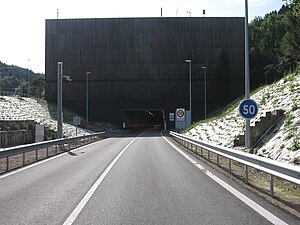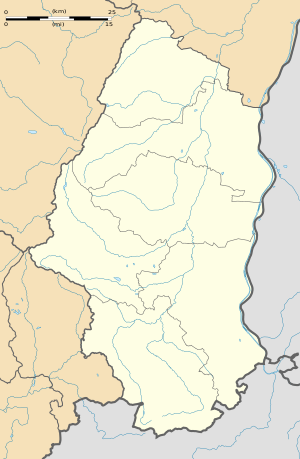Maurice Lemaire tunnel
| Maurice Lemaire tunnel | ||
|---|---|---|
|
Eastern tunnel portal
|
||
| use |
Road tunnel originally a railway tunnel |
|
| traffic connection | RN 59 | |
| place | Vosges | |
| length | 6872 m | |
| vehicles per day | 3400 | |
| Number of tubes | 1 | |
| construction | ||
| completion | 1937 | |
| location | ||
|
|
||
| Coordinates | ||
| West portal | 48 ° 17 ′ 18 ″ N , 7 ° 7 ′ 1 ″ E | |
| East portal | 48 ° 15 ′ 13 " N , 7 ° 11 ′ 36" E | |
The 6,872-meter-long Maurice-Lemaire Tunnel in France , usually referred to as the Tunnel de Sainte-Marie-aux-Mines , was opened in 1937 as a railway tunnel on the Sélestat - Lesseux - Frapelle - Saint-Dié line. Since 1976, Route nationale 59 (which is called here as an alternative route RN 159) has been subject to tolls , creating the longest road tunnel in France. The road connects Sainte-Marie-aux-Mines and Saint-Dié and saves traffic the hairpin bends over the Col de Sainte-Marie pass . The tunnel was named after the former director general of the French state railway SNCF and Minister in France (1951–1978) Maurice Lemaire (1895–1979), who campaigned for the modernization of the tunnel.
Original planning
Since 1866 there were first considerations for the construction of a tunnel to make the region "behind" the Vosges more accessible for France. The annexation of Alsace-Lorraine to the German Empire after the Franco-Prussian War of 1870/1871 initially prevented its realization. With the reorganization through the Versailles Treaty in 1919, project planning was resumed.
At the same time, a route was planned further north through the Vosges, which ended directly in Strasbourg and was completed in 1920. For this route, too, a tunnel had to be taken into account , the Tunnel de Lubine just a few kilometers north of the Maurice-Lemaire tunnel, which had the special feature of opening twice to the west because the route in the mountain described a 180-degree angle . This tunnel no longer exists today because the route was changed.
In 1937 the route from the Réseau ferroviaire d'Alsace-Lorraine including the tunnel was opened for rail traffic. Although it was actually only intended for one track, two tracks could be laid, as a larger tunnel cross-section had been determined due to the length in order to improve the ventilation of the locomotive smoke. At the time, smoke development inside tunnels was a major problem. The route runs completely straight in the north-west-south-east direction and is accessible at both entrances in the tunnel to the right with a 45-degree bend. On the Saint-Dié side the tunnel portal is at 443 m , in Sainte-Marie at approx. 356 m . The gradient is therefore around 12.7 ‰ .
Use in World War II
Between March and September 1944, the tunnel was confiscated and converted into a factory for aircraft parts. The inmates of the Struthof concentration camp served as workers . A subcamp for 800 people was hastily built at the eastern end of the tunnel at Sainte-Marie-aux-Mines (Markirch) . Most of the prisoners came from the Tržič region in present-day Slovenia . The town twinning between Sainte-Marie-aux-Mines and Tržič ', which has existed since 1966, results from this historical event. Together with the main camp, it was "evacuated" to Dachau in September 1944 . In the course book from autumn 1944 it says: “Line Markirch - St. Dié not in operation until further notice”.
Conversion into a road tunnel
With the liberation of France, the tunnel was returned to its original use as a railway line. In 1973, the SNCF railway administration decided to close the line and sell the tunnel to the regional administration. Plans had been in place since 1966 that would be converted into a road tunnel. The national road 59 was previously led over a pass road that led to a height of 772 meters. The road could not always be kept free of snow and ice. After a renovation, the road tunnel was opened in February 1976. The tunnel itself and the access road from St. Dié were given the number 159 because the pass road continued to operate under the RN 59. This designation was changed at the apex, which is also the border between Alsace and Lorraine , on the mountain side to Sainte-Marie in D 459, because the maintenance obligation should not be incumbent on the state but on the municipality. Much of the road runs right through the village of Sainte-Marie.
Of the 3,400 vehicles that drive through the tunnel every day, around 40% are trucks . It is an important traffic artery, which from the beginning significantly increased the economic attractiveness of the Vosges border region. The tunnel is not permitted for the transport of dangerous goods .
Another renovation
The fire in the Mont Blanc tunnel in March 1999, in which 39 people died, caused the operators of the Maurice Lemaire tunnel to implement basic safety standards. The tunnel was initially closed to trucks, from April 2004 to all traffic, so that safety devices could be installed. The central, new structure was a second, parallel safety tunnel with a diameter of six meters. This is connected to the main tunnel at regular intervals. The tunnel has been open to traffic again since October 2008.
After the renovation, the through toll has increased significantly and is now EUR 8.00 for cars and EUR 5.60 for motorcycles . The extreme increase in heavy goods traffic from around 10 to 63, since 2016 65 euros, has meant that many trucks prefer the pass route for reasons of cost , which is a considerable burden on the neighboring villages.
Web links
- PowerPoint presentation on the history of the tunnel with many photos (French) (Memento from the Internet Archive from December 22, 2015)
Individual evidence
- ↑ E. & R. Cellarius: Inauguració del túnel Santa-Casa-a les-Mines-Llegís per Senyor Albert Lebrun, President de la República Francesa, el 8 d'agost de 1937 (German: inauguration of the Maurice-Lemaire tunnel by President Albert Lebrun on August 8, 1937), Ed .: Imprimerie Typographique Et Lithographique, 1937
- ↑ Archived copy ( memento of the original dated December 22, 2015 in the Internet Archive ) Info: The archive link was inserted automatically and has not yet been checked. Please check the original and archive link according to the instructions and then remove this notice.
- ^ Course book from autumn 1944
- ↑ a b APRR TARIFS DE PÉAGE (PDF; 297 kB)
- ↑ Focus: Vosges tunnel in France reopened
- ^ Badische Zeitung: Expensive toll for trucks

